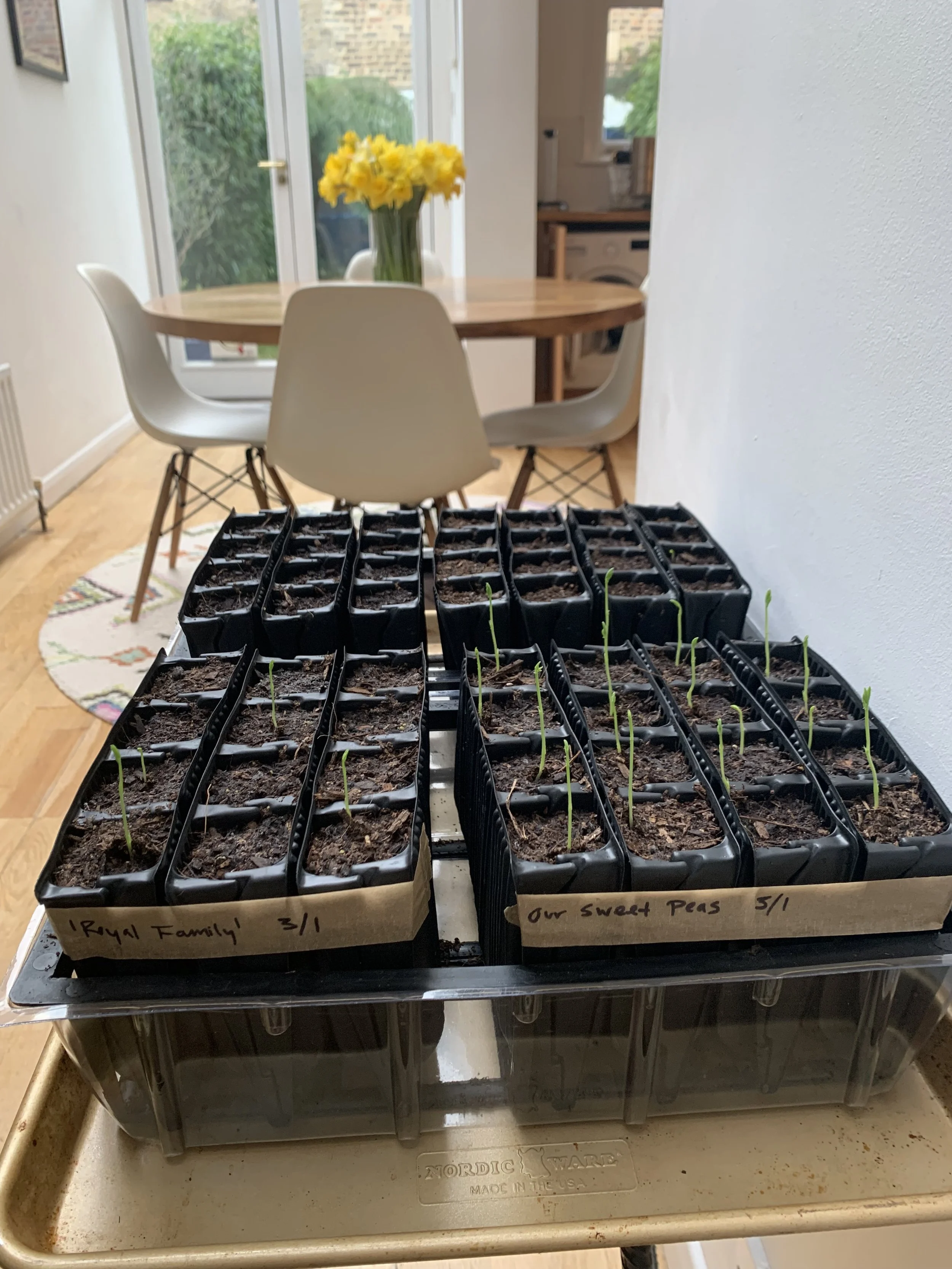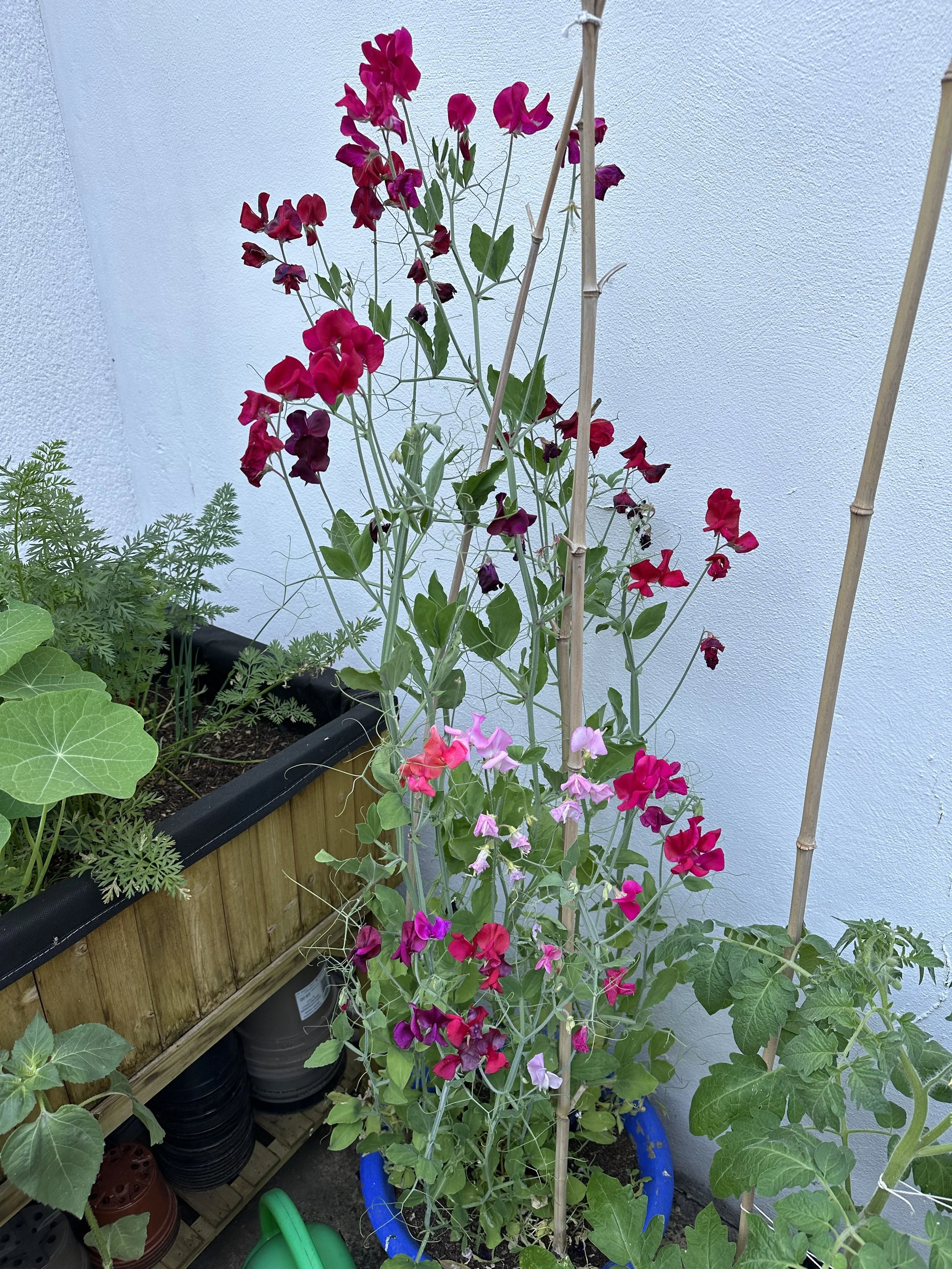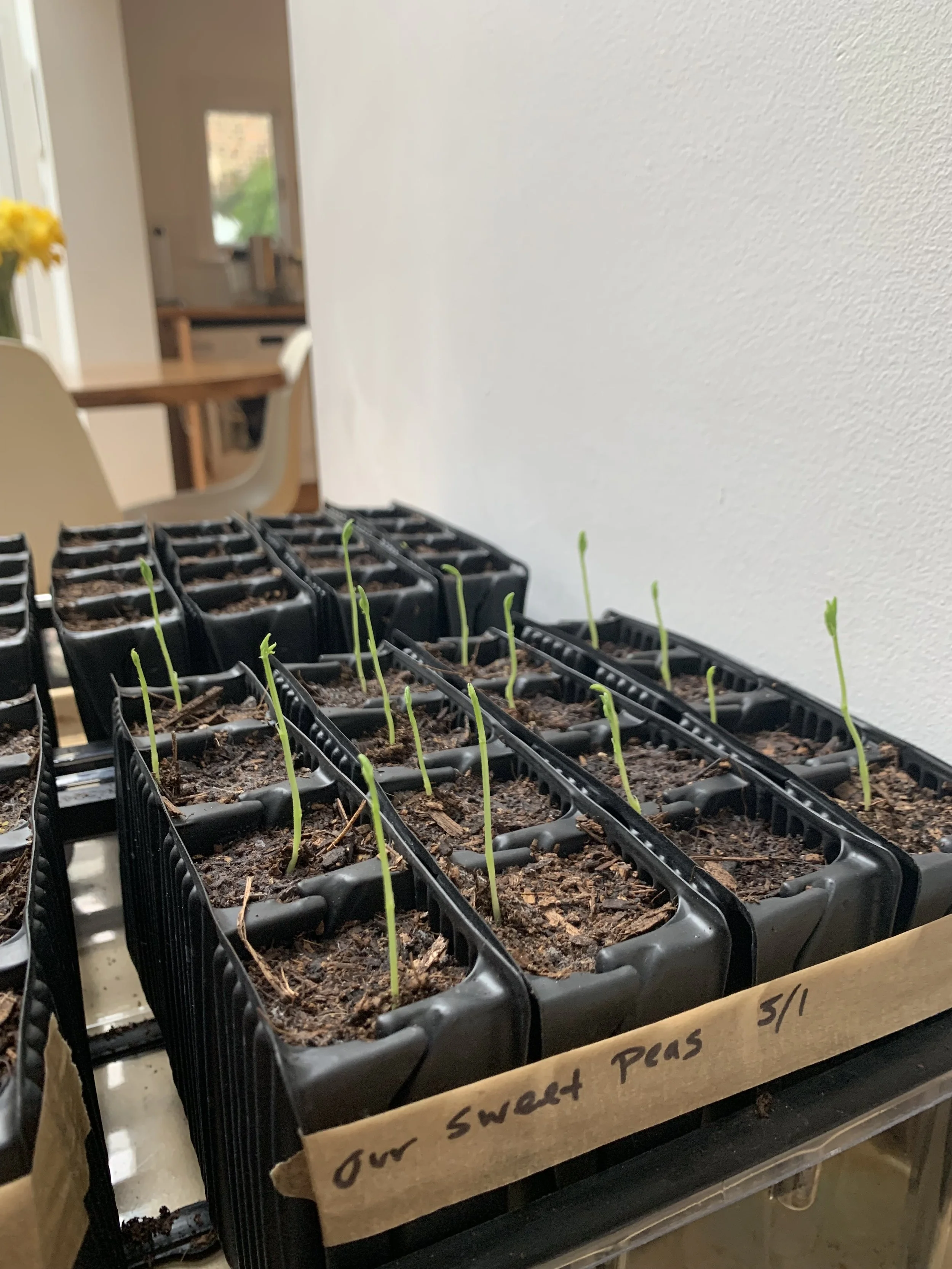Sweet Peas: When to Plant Seeds
This website is reader-supported - thank you! This post may contain affiliate links. As an Amazon Associate, I earn from qualifying purchases at no extra cost to you.
Ready to add some color and fragrance to your garden? Sweet peas are your go-to.
These little beauties are not only stunning with their vibrant colors, but they also fill the air with their sweet scent.
Growing sweet peas is really rewarding and very straightforward.
In this guide, I'll walk you through the best times to plant sweet pea seeds and how to keep them happy and blooming.
So, let’s roll up our sleeves and get your garden buzzing with some sweet pea magic.
To learn more about growing sweet peas, check out my guides:
Creative Support Ideas for Thriving Sweet Peas
Sweet Peas Powdery Mildew: How to Avoid It
And to learn more about growing from seed, check out my guide:
I love growing sweet pea seeds in root trainers as they develop long, sturdy roots which make transplanting really easy.
When to Plant Sweet Pea Seeds
The secret to a breathtaking sweet pea display lies in understanding the perfect planting time.
Sweet peas are a bit particular about their start in life, and getting this right can mean the difference between a mediocre showing and stunning display.
Key Factors in Timing
When planning to sow sweet pea seeds, several key factors need to be considered to ensure optimal growth and blooming.
These factors largely revolve around local climate conditions and the specific needs of sweet pea plants.
1. Understanding Your Region's Last Frost Date
Crucial for Timing: The last frost date in your region is the most critical factor to consider.
Sweet pea seeds need to be planted at a time when they are unlikely to be exposed to the harsh conditions of late winter frosts, which can hinder germination or damage young seedlings.
Local Variations: Since the last frost date varies significantly depending on geographic location, it's important to consult your local meteorological services for accurate information.
For instance, gardeners in northern climates will have a later last frost date compared to those in the south.
The Farmer’s Almanac has a great interactive map with average frost dates by location, check it out here.
Start your own cut flower garden with my guide:
2. Matching Planting Time to Climate Zones
Zone 5: In cooler climates, such as Zone 5, the window for planting sweet pea seeds typically falls in late winter to early spring.
This might mean aiming for a planting date in March or even late February, depending on specific local weather patterns.
Zone 7: In these slightly warmer areas, planting can often begin earlier, sometimes as soon as late February, to take advantage of the early onset of spring.
Warmer Regions (e.g., Texas): In these locales, the planting season can start even earlier.
Gardeners might find January or early February suitable for sowing sweet pea seeds, utilizing the mild winter conditions to get a head start.
For more tips, check out my guide: Seeds to Sow in January.
3. Soil Temperature Considerations
Ideal Range: Sweet pea seeds germinate most effectively in soil temperatures ranging from 55°F to 65°F (13°C to 18°C).
Planting when the soil is within this temperature range is crucial for successful germination.
Checking Soil Temperature: Use a soil thermometer to measure the temperature at the depth where seeds will be planted.
This helps in determining the optimal planting time, which might slightly vary from the general guidelines based on the last frost date.
Here is the soil thermometer I recommend using:
Advanced Tips for Optimal Growth
1. Pre-Soaking Seeds for Faster Germination
Soaking Process: Before planting, soak the sweet pea seeds in water for 24 hours.
This process softens the hard seed coat, which can otherwise slow down germination.
The soaking should be just long enough to plump up the seeds but not so long that they begin to disintegrate.
Enhanced Germination: Pre-soaked seeds typically germinate more quickly and evenly, providing a head start in growth and development.
2. Starting Seeds Indoors for Early Blooms
Indoor Sowing: In regions with longer winters, starting sweet pea seeds indoors can be beneficial.
Sow the seeds in biodegradable pots or root trainers about 4-6 weeks before the expected last frost date.
This early start can lead to stronger, more established plants by the time they are moved outdoors.
When transplanting, handle the seedlings carefully to avoid disturbing the roots.
Plant them directly in the garden, pot and all, to minimize root shock.
Here are my favorite root trainers for growing sweet peas with long healthy roots:
3. Implementing Successive Planting for Extended Blooms
Staggered Planting: Plant a new batch of sweet pea seeds every 2-3 weeks until mid-spring.
This technique, known as successive planting, ensures a continuous display of flowers as different plants will reach maturity at different times.
Longer Flowering Season: Successive planting extends the blooming period of your sweet peas, keeping your garden vibrant and fragrant for a more extended period.
4. Pinching for Bushier Growth
Pinching Technique: When sweet pea seedlings have developed a few pairs of true leaves, pinch out the tips.
This encourages the plant to branch out, leading to a bushier growth habit.
More Flowers: Bushier plants typically produce more stems, which in turn leads to a greater abundance of blooms.
5. Optimal Feeding for Healthier Plants
Compost and Manure: Incorporating well-rotted manure or compost into the soil at planting time provides the plants with essential nutrients and improves soil structure.
Balanced Fertilization: Feed sweet peas with a balanced, water-soluble fertilizer every 2-4 weeks.
Be cautious with high nitrogen fertilizers, as they can encourage more foliage at the expense of flowers.
Check out my guide Does Fertilizer Go Bad? The Reality of Fertilizer Shelf Life.
6. Regular Deadheading to Encourage More Blooms
Removing Spent Flowers: Regularly remove spent blooms (deadheading).
This prevents the plants from setting seed, encouraging them to produce more flowers.
Continuous Display: Consistent deadheading keeps plants looking tidy and stimulates continued flowering throughout the season.
To learn more about growing from seed, check out my guides:
For more growing tips, check out my guide:
Caring for Your Sweet Peas
Sweet peas are not overly demanding, but they do require attention to certain details to ensure their best growth and flowering.
Here is how to provide your sweet peas with the care they need.
1. Watering: Keeping the Balance Right
Consistent Moisture: Sweet peas prefer consistent moisture in the soil.
Ensure regular watering, especially during dry spells.
Overwatering, however, can be detrimental, leading to root rot, so it’s essential to find a balance.
For more watering tips, check out my guide How Often to Water Seedlings.
Mulching: Applying a layer of organic mulch around the plants can help retain soil moisture and keep roots cool, which is particularly beneficial during hot weather.
For more mulching tips, check out my guide The Best Alternatives to Traditional Mulch for Your Garden.
2. Sunlight: The More, the Merrier
Full Sun: Sweet peas thrive in full sun, needing at least 6 hours of direct sunlight per day.
An adequate amount of sun is crucial for optimal flowering.
A south-east, south or west-facing garden is best for growing sweet peas.
Partial Shade Tolerance: While they prefer full sun, sweet peas can tolerate partial shade, especially in hotter climates where afternoon shade can prevent overheating.
3. Soil Requirements: Rich and Well-Drained
Soil Quality: Sweet peas favor rich, well-drained soil.
Before planting, enrich the soil with compost or well-rotted manure to boost nutrient levels.
In order to make your own compost, check out my guide How to Start Composting in a Tumbler.
pH Levels: They generally prefer a neutral to slightly alkaline soil pH.
Test your soil’s pH and amend it according.
Here is the soil pH tester I use:
4. Support Structures: Climbing High
Climbing Support: As climbing plants, sweet peas need support to grow upwards.
Provide trellises, nets, or stakes for them to cling to as they grow.
To learn more about how to do this, check out my guide Creative Support Ideas for Thriving Sweet Peas.
Training Young Plants: Gently tie young plants to the support structures until they begin to climb on their own.
5. Pruning and Deadheading: Encouraging More Blooms
Regular Pruning: Prune your sweet peas regularly to encourage branching, which leads to more flowers.
Deadheading: Remove spent blooms frequently.
This not only keeps the plants looking neat but also stimulates further flowering, as the plant redirects energy from seed production to creating new blooms.
6. Pest and Disease Management
Monitoring: Keep an eye out for common pests like aphids and caterpillars, as well as diseases like powdery mildew.
Preventative Measures: Good air circulation, proper spacing, and avoiding overhead watering can help prevent many common diseases.
For pests, consider using insecticidal soaps or natural predators like ladybugs.
7. Fertilization: Feeding for Growth
Balanced Fertilizer: Apply a balanced, water-soluble fertilizer every few weeks during the growing season.
Avoid high nitrogen fertilizers, as they can lead to lush foliage at the expense of flowers.
Organic Options: Using organic fertilizers like fish emulsion or seaweed extract can promote healthy growth and blooming.
Here is the fertilizer I recommend:
To learn more about growing sweet peas, check out my guide:
‘Royal Family’ sweet peas grown from seed.
Creating a Cut Flower Garden with Sweet Peas
Sweet peas are a fantastic choice for a cut flower garden.
With their incredible fragrance and vibrant colors, they can bring the beauty of your garden indoors.
Here is how to optimize your sweet pea plants for the longest vase life and create a stunning cutting garden.
1. Selecting Sweet Peas for Your Cut Flower Garden
Variety Matters: When choosing sweet peas for cut flowers, look for varieties known for their long vase life and robust stems.
These traits are essential for cut flowers to maintain their beauty after being picked.
Here are the varieties I recommend growing:
2. Planting for a Continual Supply
Seeds Per Pot: If you're starting sweet peas in pots, sowing 2-3 seeds per pot is ideal.
This ensures that at least one strong plant will emerge in each pot.
Cutting Garden Layout: In a cutting garden, space your sweet pea plants about 6-8 inches apart to give them ample room to grow.
This spacing allows for better air circulation and easier access for cutting.
3. Tips for the Longest Vase Life
Harvesting at the Right Time: Cut sweet pea flowers early in the morning when their water content is highest.
This helps to ensure they'll last longer once cut.
Frequent Cutting: Regularly cutting sweet pea flowers encourages the plant to produce more blooms, keeping your garden and your vases full.
The more you cut, the more they bloom.
5. Caring for Cut Flowers
Immediate Care: After cutting, place sweet pea stems in water immediately.
Use a clean vase and fresh water to prolong their vase life.
Changing Water: Change the water in the vase every couple of days and trim the stems slightly each time.
This helps the flowers to better absorb water and stay fresh longer.
6. Sweet Peas as Annual Flowers in Your Garden
Annual Beauty: Remember that sweet peas are annual flowers, so they will need to be replanted each year.
This allows you to experiment with different varieties and colors in your cutting garden annually.
To learn more about growing annual flowers, check out my guide Top 12 Easy to Grow Hardy Annuals.
Growing sweet peas and harvesting them as cut flowers is the best feeling.
FAQs
Is it too late to plant sweet peas?
Timing Flexibility: The ideal time to plant sweet peas is in early spring, after the last frost.
However, if you missed this window, it's not necessarily too late.
In milder climates, sweet peas can still be planted a bit later and produce a good display of flowers.
Late Planting Implications: Keep in mind that planting later might result in fewer blooms or a delayed flowering period.
The plants might also be more susceptible to heat stress in the peak of summer, especially in warmer regions.
Do sweet peas come back every year?
Annual Nature: Sweet peas are annual plants, meaning they complete their life cycle in one year and do not typically come back the following season.
Self-Seeding Potential: However, if the flowers are allowed to go to seed and the conditions are right, sweet peas can self-seed in your garden.
This can result in new plants emerging the following year, but it's not guaranteed, and the new plants may not be true to the parent plant's characteristics.
What is the ideal germination temperature for sweet pea seeds?
Optimal Temperature Range: Sweet pea seeds germinate most effectively in a soil temperature range between 55°F and 65°F (13°C to 18°C).
Maximizing Germination: To achieve the best germination rate, consider starting seeds indoors where you can more easily control the temperature, or wait until outdoor soil temperatures fall within this range before planting.
How tall do sweet peas grow?
Variety-Dependent Growth: The height of sweet peas can vary significantly depending on the variety.
Some dwarf varieties may grow only about 12-18 inches tall, while traditional climbing varieties can reach heights of 6-8 feet or more when provided with adequate support.
Support for Climbing Varieties: For the taller varieties, providing a trellis, fence, or other support structure is essential to accommodate their climbing nature and ensure optimal growth and flowering.
Learn more about this in my guide Creative Support Ideas for Thriving Sweet Peas.
My little vase that I keep filled with cut sweet peas throughout the season.
Sweet pea seedlings growing in root trainers.
Growing sweet peas is as rewarding as it is fun.
With these tips and tricks under your belt, you're well on your way to having a garden filled with colorful, fragrant blooms.
The key to sweet pea success lies in understanding their needs – right from planting at the perfect time, providing them with a bit of care, to enjoying their beautiful blooms as cut flowers.
So go ahead, give it a go, and watch as these charming flowers transform your garden.
Pin this post to save it for later!














































